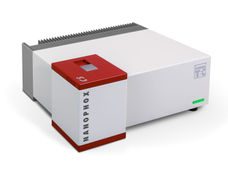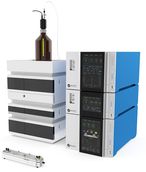New method for measuring the temperature of nanoscale objects
Temperature measurements in our daily life are typically performed by bringing a thermometer in contact with the object to be measured. However, measuring the temperature of nanoscale objects is a much more tricky task due to their size - up to a thousand times smaller than the width of a human hair.
Pioneering research, published in Nature Nanotechnology, has now developed a method to accurately measure the surface temperature of nanoscale objects when they have a different temperature than their environment. A team led by Dr Janet Anders at the University of Exeter and Professor Peter Barker at University College London have discovered that the surface temperatures of nanoscale objects can be determined from analysing their jittery movement in air - known as Brownian motion.
"This motion is caused by the collisions with the air molecules" said Dr Anders, a quantum information theorist and member of the Physics and Astronomy department at the University of Exeter. "We found that the impact of such collisions carries information about the object's surface temperature, and have used our observation of its Brownian motion to identify this information and infer the temperature."
The scientists conducted their research by trapping a glass nanosphere in a laser beam and suspending it in air. The sphere was then heated and it was possible to observe rising temperatures on the nanoscale until the glass got so hot that it melted. This technique could even discern different temperatures across the surface of the tiny sphere.
"When working with objects on the nanoscale, collisions with air molecules make a big difference", says Dr. James Millen from the team at University College London. "By measuring how energy is transferred between nanoparticles and the air around them we learn a lot about both".
Accurate knowledge of temperature is needed in many nanotechnological devices because their operation strongly depends on temperature. The discovery also informs current research which is working towards bringing large objects into a quantum superposition state. It further impacts on the study of aerosols in the atmosphere and opens the door for the study of processes that are out of equilibrium in a controlled setting.
Brownian motion is named after the Scottish botanist Robert Brown who, in 1827, noted that pollen move through water even when the water is perfectly still. Albert Einstein published a paper in 1905 that explained in precise detail how this movement was a result of the pollen being pushed by individual water molecules, eventually leading to the acceptance of the atomistic nature of all matter in science.
Most read news
Organizations
Other news from the department science
These products might interest you

NANOPHOX CS by Sympatec
Particle size analysis in the nano range: Analyzing high concentrations with ease
Reliable results without time-consuming sample preparation

Eclipse by Wyatt Technology
FFF-MALS system for separation and characterization of macromolecules and nanoparticles
The latest and most innovative FFF system designed for highest usability, robustness and data quality

DynaPro Plate Reader III by Wyatt Technology
Screening of biopharmaceuticals and proteins with high-throughput dynamic light scattering (DLS)
Efficiently characterize your sample quality and stability from lead discovery to quality control

Get the chemical industry in your inbox
By submitting this form you agree that LUMITOS AG will send you the newsletter(s) selected above by email. Your data will not be passed on to third parties. Your data will be stored and processed in accordance with our data protection regulations. LUMITOS may contact you by email for the purpose of advertising or market and opinion surveys. You can revoke your consent at any time without giving reasons to LUMITOS AG, Ernst-Augustin-Str. 2, 12489 Berlin, Germany or by e-mail at revoke@lumitos.com with effect for the future. In addition, each email contains a link to unsubscribe from the corresponding newsletter.
Most read news
More news from our other portals
Last viewed contents
Decomposition
PolyOne to Report Three Non-Core Units as Discontinued Operations

Controlling the properties of graphene transistors using pressure
Flavonoid
IEC and ISO common database for graphical symbols now available online
Heap_leaching




























































